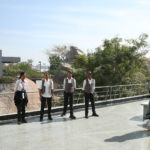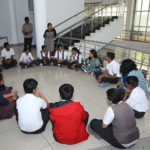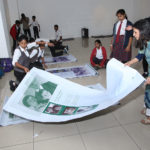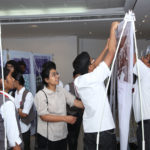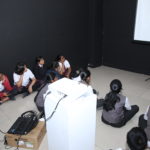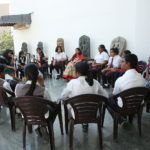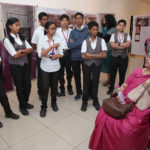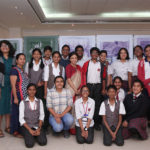2019 didn’t just begin, it toppled in rather unceremoniously. On the second day of the new year, Megha and I set off for Hyderabad where ‘Anne Frank: A History for Today’ was invited to be a part of the 16th edition of Krishnakriti Foundation’s Arts and Culture festival– a host of firsts for my two-month old PeaceWorks self.
After a slightly rocky start involving a lost driver among other factors, we finally began.
Day 1. Peer guide training [3.1.2019]
- Background setting–The magnificent if somewhat abandoned looking interiors of the State Gallery of Art
- Time–A winter morning to make Kolkata’s seem arctic
- Scene–Fifteen smartly dressed adolescents from Silver Oaks International and Glendale Academy (class 9 and 11 respectively) exhibiting varying degrees of doubt and excitement.
Having conducted the introductions via a fun memorizing-through-dance move game, we sat down in a circle to discuss what the day would have in store. Each of the students was acquainted with Anne Frank’s diary and to our excitement, with a basic idea of the socio-political conditions of the times in which she lived. Reminiscing her visit to the Anne Frank House in Amsterdam, Megha shared with the students the vision and reach of the initiative, asking them why they thought Anne’s records among other similar documents had struck a chord with readership worldwide to the extent it had. The students had a number of sharp takes on this – the political conditions may have affected what could be published and what couldn’t, the magnitude of the war and its repercussions as seen through a 13-year old’s lens had a unique impact, among others.
ccccIn addition to the refreshing level of the students’ involvement in this circle time, I personally found it quite helpful and educative to observe (and gradually participate in) Megha’s approach to facilitating the discussion, teasing out responses- big or small, from even the most reserved of the students.
ccccWith everyone having gained a rough overall idea regarding what we had ahead of us, we got down to the physical work following Megha’s demonstration of the process of setting up panels. Divided into groups of 3, the students set about doing this methodically, with Megha and I running around to guide/help in tricky situations. This took a good two hours, leaving the students glad at the novelty of having the chance to personally install the panels and exhausted and eager for lunch.
Energy reinforced, we next addressed the matter of design. Excited at the prospect of laying out an exhibition themselves, the students offered insightful suggestions on lighting and space. We collectively set about applying their ideas and structuring the installations until we reached a practical layout based on considerations the students came up with through multiple trial and error efforts. This was followed by a screening of The Short Life of Anne Frank.
Day 2. Peer guide training cont. [4.1.2019]
We began Day 2 sitting in a circle, opening with the question: What did you do when you got home last evening? While a few students declared ‘Slept!’ amidst much laughter, one student told us about a documentary she watched on the Holocaust which helped everyone ease into an open discussion on their thoughts and feelings on the subject. The discussion required minimal interference from Megha and I as the students discussed and debated a wide range of questions- did Hitler do it because of personal reasons? How did he influence so many people? Why did people listen to him? Was Hitler inhuman, is hate?
ccccAll questions that they actively responded to in their own ways, with occasional inputs and navigational questions from Megha and I. Megha pointed out the involvement of the common people in the everyday industry that was the Holocaust, from the builders of concentration camps to the suppliers of gas to the chambers, while I discussed the human tendency to imagine a definite circle to create an outer and inner logic/rhetoric, using an account from a seminal anthropologist’s records. The discussion soon moved to the role of media in building popular opinion, with the students drawing links with multiple instances from current international affairs which we helped direct inwards, within India as well. The students were then assigned an hour to browse through the installations and familiarize themselves with the panels.
cccc Towards the end of this hour, we had a completely unexpected visitor in the form of Prof. Aloka Parasher-Sen, Professor Emeritus at the University of Hyderabad. Nervous excitement reigned among the students– there’s another circle time left! It’s too early for visitors, we are not ready yet. This however turned out to be the most fortuitous of surprises. Prof. Parasher-Sen took the time to dedicatedly go through each panel, asking questions, drawing the peer guides’ attention to possible areas of reflection, pointing out areas in the guides’ overall narratives that could be strengthened.
ccccAt circle-time after this enriching session, we asked the students for feedback on their debut as peer-guides. Through a sharing of opinions and self- and peer-critiques, we collectively began to shape the role and responsibilities of a sensitive peer-guide. A long fruitful discussion later, the students felt far more certain of what they wanted to convey to the visitors in an exhibition most of whose information was already available for the visitors to read, and how.
ccccSince the official opening was past 8 PM, the peer guides left for the day after guiding a few pre-opening visitors who commended the confidence of the students. The exhibition saw a sizeable number of visitors after the opening, including Rekha Lohati (co-founder of the Kalakriti Art Gallery), many of whom promised to visit again for the experience of being facilitated by the peer-guides.
-Ranita Ray.

